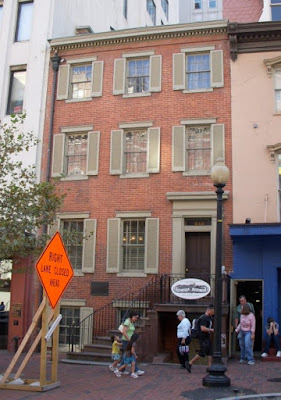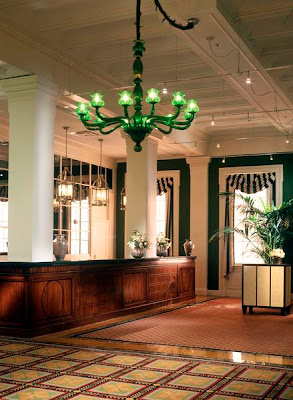 Q
Q  & A with Mary Oehrlein
Historic Preservation Officer for the
Architect of the Capitol
By Beth Herman
& A with Mary Oehrlein
Historic Preservation Officer for the
Architect of the Capitol
By Beth Herman On February 28, Mary Oehrlein became the second historic preservation officer in history for the Architect of the Capitol. In her new capacity, she oversees 17 million s.f. of existing buildings within the Capitol jurisdiction in what she calls “a constant state of upgrade,” including the Capitol, Supreme Court, Botanical Gardens and all House and Senate office buildings. Oehrlein joins a legion of 2,600, including skilled tradespeople and artisans, who comprise the behemoth staff.
As founder and president of Mary Oehrlein & Associates in 1984, a D.C.-based firm specializing in historic preservation, Oehrlein executed the restoration of many dozens of Washington and regional landmarks including St. Matthews Cathedral and Peterson House (where Lincoln died). The firm oversaw the exterior restoration of the damaged wing of the Pentagon, the stone  conservation of the Washington Monument, and preservation of the historic buildings at Jefferson/Clara Barton residences, Terrell Place Offices and Residences, Lansburgh’s, Gallery Row and National Institutes of Sciences. It also renovated the General Post Office - the first post office of the United States - in its transition to the Hotel Monaco. DCMud checked in with Oehrlein about her new role.
conservation of the Washington Monument, and preservation of the historic buildings at Jefferson/Clara Barton residences, Terrell Place Offices and Residences, Lansburgh’s, Gallery Row and National Institutes of Sciences. It also renovated the General Post Office - the first post office of the United States - in its transition to the Hotel Monaco. DCMud checked in with Oehrlein about her new role.
 conservation of the Washington Monument, and preservation of the historic buildings at Jefferson/Clara Barton residences, Terrell Place Offices and Residences, Lansburgh’s, Gallery Row and National Institutes of Sciences. It also renovated the General Post Office - the first post office of the United States - in its transition to the Hotel Monaco. DCMud checked in with Oehrlein about her new role.
conservation of the Washington Monument, and preservation of the historic buildings at Jefferson/Clara Barton residences, Terrell Place Offices and Residences, Lansburgh’s, Gallery Row and National Institutes of Sciences. It also renovated the General Post Office - the first post office of the United States - in its transition to the Hotel Monaco. DCMud checked in with Oehrlein about her new role. DCMud: The position of historic preservation officer for the AOC wasn’t created until 2006. What precipitated it?
Oehrlein: One of the goals of the AOC is preservation. It’s always been an underlying thought, but until 2006, no one had expressly written about preserving these buildings, along with their landscapes and art, monuments and memorials, paintings, murals and decorative painting, beautiful bronze railings and monumental bronze doors. There’s a great  wealth of material, and it wasn’t a stated policy that among the AOC’s missions was to preserve all of this.
wealth of material, and it wasn’t a stated policy that among the AOC’s missions was to preserve all of this.
 wealth of material, and it wasn’t a stated policy that among the AOC’s missions was to preserve all of this.
wealth of material, and it wasn’t a stated policy that among the AOC’s missions was to preserve all of this. DCMud: Mary Oehrlein & Associates is among D.C.’s preeminent historic preservation architecture firms and has been in existence since 1984. What led to your decision to close up shop and accept the position of historic preservation officer for the Architect of the Capitol?
Oehrlein: I haven’t entirely closed my firm, but it all happened very fast. I’d been thinking for some time that I’d like to do something different and not continue to run my own office forever. I’d joked with the person who was in this office previously, Bill Allen (long time architectural historian who’d held the newly-mandated position since 2006). I said, “Bill, I really want your job. I can’t think of anything that would be more fun.” He always told me to wait until he retired. DCMud: And when did that occur?
DCMud: And when did that occur?
 DCMud: And when did that occur?
DCMud: And when did that occur? Oehrlein: He retired last year, and the job was posted. I wasn’t really looking at that point, but submitted my qualifications by December and it all fell into place. I had to decide what to do with my firm. I love what I do, but some days the management aspects were a lot to handle. It’s time consuming to deal with contracts and proposals and personnel issues and office leases – everything that goes along with running an office. I was ready for a change.
DCMud: How has that change manifested for you?
Oehrlein: This is just ideal. I am working in the best building in the country, doing pretty much what I love to do, which is preservation. My job is to review projects that are happening here and set policy for preservation of the buildings. I identify what’s significant and what needs to be retained and preserved: It’s everything from policy, management and implementation to specific project review and writing specifications for preservations and maintenance.
Oehrlein: There’s always a lot going on with these buildings – a lot of projects underway. These include a range of tasks from replacing light fixtures to major mechanical overhauls. Replacing all the plumbing piping in the Capitol is a project that’s in the planning stages now.
DCMud: What are some of the inherent challenges?
Oehrlein: Well, how do we do things without impacting the really decorative finishes, artwork and decorative arts in the building, or the ornamental plaster or marble floors. How are these projects accomplished in the best way possible with a minimal amount of intervention and impact? Those are the big projects, but sometimes it comes down to something as simple as the masonry shop wants to point a building, and they ask about materials and procedures. Issues range from technical to planning.
DCMud: In your few short months in the position, is there anything you’ve observed that you’d like done differently? Oehrlein: I would like there to be more ongoing maintenance. I’ve always been a proponent of maintaining buildings rather than allowing them to deteriorate, and then having to spend a lot of money to repair and restore them. One of my goals is to increase the focus on basic, good quality cyclical maintenance of all the materials we deal with: historic windows; exterior stone; all the beautiful bronze that’s here; artwork; decorative arts.
Oehrlein: I would like there to be more ongoing maintenance. I’ve always been a proponent of maintaining buildings rather than allowing them to deteriorate, and then having to spend a lot of money to repair and restore them. One of my goals is to increase the focus on basic, good quality cyclical maintenance of all the materials we deal with: historic windows; exterior stone; all the beautiful bronze that’s here; artwork; decorative arts.
 Oehrlein: I would like there to be more ongoing maintenance. I’ve always been a proponent of maintaining buildings rather than allowing them to deteriorate, and then having to spend a lot of money to repair and restore them. One of my goals is to increase the focus on basic, good quality cyclical maintenance of all the materials we deal with: historic windows; exterior stone; all the beautiful bronze that’s here; artwork; decorative arts.
Oehrlein: I would like there to be more ongoing maintenance. I’ve always been a proponent of maintaining buildings rather than allowing them to deteriorate, and then having to spend a lot of money to repair and restore them. One of my goals is to increase the focus on basic, good quality cyclical maintenance of all the materials we deal with: historic windows; exterior stone; all the beautiful bronze that’s here; artwork; decorative arts. DCMud: Is there a particular project on which you are currently working that might raise  some eyebrows?
some eyebrows?
 some eyebrows?
some eyebrows?Oehrlein: I’m working on a major project currently in the predesign phase: a total rehabilitation of the Cannon House Office Building. The last major intervention was in 1966, and it involves all new mechanical, electrical and plumbing systems. Forty-five years is a long time for systems to continue to operate, and work is slated to begin in another five years in 2016.
DCMud: For your first job working for a construction company that was doing restoration work, before preservation architecture was even practiced, you once said you spent months in the stacks at the Library of Congress researching historic preservation materials and procedures. Those were the days that the public had largely unlimited access to the stacks, which it no longer has. As historic preservation officer, presumably you will once again have access. Had you thought about that?
Oehrlein: (Laughing) I have to say that’s one of the things I thought about when I accepted this position, that wow, I’ll have access to the stacks again.
DCMud: And what about your own firm?
Oehrlein: It’s still functioning and probably will be through the end of the year. I’m at the AOC during the day and working nights and weekends to keep up with things privately. We are also clearing out 30 years’ worth of project files, books, records, drawings and photographs from the firm that need to be disposed of, moved, packed and/or stored. Some of the work is going to the D.C. library, and the Washington Historical Society is taking some of the photographs as we always took them before we started our work.
DCMud: Is there anything we haven’t asked about which readers may be curious?
Washington DC commercial design news







0 comments:
Post a Comment
Commercial ads will be deleted, so don't even think about it.